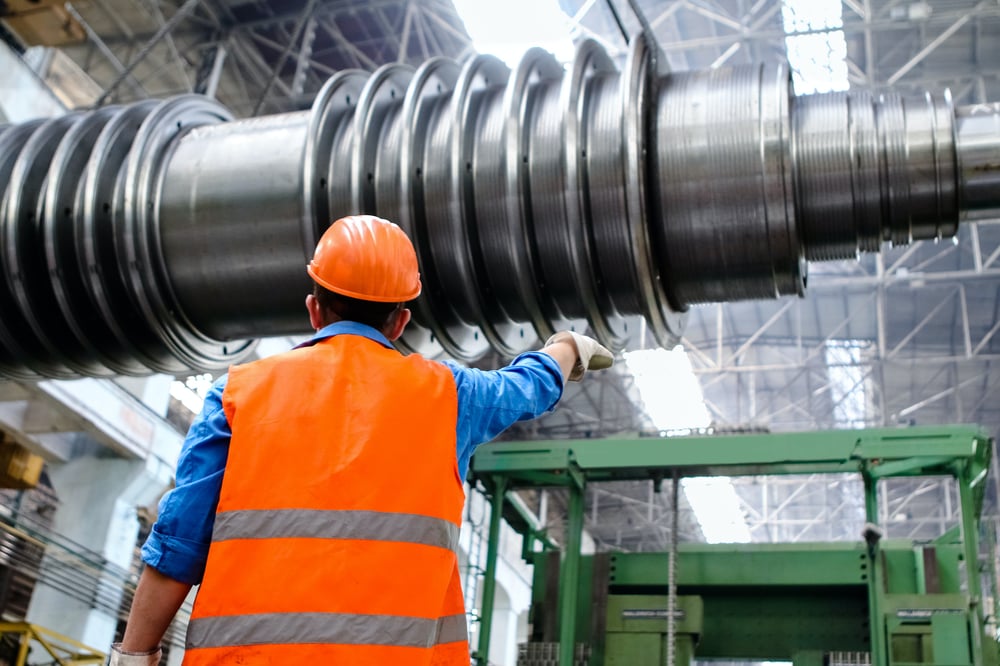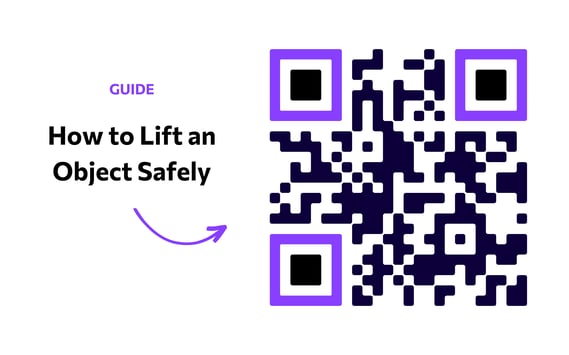Safety is important in any workplace. However, it plays an even larger role within the manufacturing industry where employees often work in an unpredictable environment while operating heavy machinery.
Although safety in manufacturing has come a long way—14,700 work-related deaths in 1970 compared to 5,250 in 2018—there’s still more work to be done to reduce both fatalities and injuries.
However, employers need to extend their scope beyond simply reducing injuries. A safer working environment also improves workforce productivity, fosters employee engagement, and reduces costs.
It is imperative manufacturers optimize their workplace safety standards and adopt modern and progressive ideas that are proven to reduce injury and improve workforce performance.
Keep reading for some example safety training topics, and to find out what you can do to optimize your own manufacturing safety training.

Safety Topics for Manufacturing
1. Equipment
When assessing risk, equipment typically tops the list. Many manufacturers utilize heavy machinery capable of causing serious injury and, in some cases, death. Coupled with the fact that misusing machinery is a major cause of workplace injury, highlighting how to use and maintain equipment becomes a no-brainer.
Make sure your workers are using equipment only for its intended purpose and highlight the need for cleaning and inspecting equipment in order to reduce the likelihood of fires and failures. Storing equipment properly is another element that is sometimes overlooked.
2. PPE
Wearing proper safety equipment (PPE) when handling equipment is vital for workplace safety. PPE can include goggles, gloves, footwear, hardhats, and anything else needed to do a job safely.
Having the right equipment is only half the battle. Direct your workforce on how to correctly wear the PPE- e.g., goggles must fit well and be positioned correctly, and hardhats must be worn the right way round, with the bill of the cap pointing toward the front of the hat.
PPE is especially important for workers handling hazardous materials and chemicals. Consider the use of hazmat suits and gas masks if necessary.
3. Hazards
There are a number of different hazards present in a manufacturing facility. Some are immediate threats to employee safety, whereas others develop over time.
An example of the latter includes ergonomic hazards that are a result of repetitive motion, heavy lifting, and loud noises that can cause long-term damage to the well-being of your workforce. Immediate hazards include chemical, fire, and biological.
4. Slips, Trips, and Falls
Falls are one of the three most common and costly causes of disability injury.
Preventing slips, trips, and falls requires a regular assessment of working conditions. It’s your responsibility to train your workforce on how to accurately assess the environment in order to reduce slips, trips, and falls. What best practices prevent falls? If there is a slip, what’s the first step in dealing with it? These are questions your employees need answered.
5. Incident Reporting
Incident reporting is critical to your workplace safety program. All incidents should be reported, documented, and investigated. Doing so will reduce injuries, efficiently deal with any current injuries, and will reduce injury costs in the long term.
Incident reporting processes differ between workplaces, however, they should be seamless and easily understood by your workforce. A clunky, complicated method might discourage employees from reporting due to not knowing how or an unwillingness to go through a time-consuming process.
6. Hazardous Waste Management
Hazardous waste is waste that contains substances that are potentially harmful to human health or the environment.
Industrial waste management is governed by numerous regulations, and manufacturers must remain informed on current laws in order to avoid warnings, fines, and closures.
American manufacturers should follow the EPA guidelines when it comes to disposing of waste and should avoid making guesses about what is and isn’t hazardous.
7. Hand Safety
Almost 20% of disabling accidents in manufacturing involve the hands. That’s why it’s imperative manufacturers take appropriate action to protect the hands of their workers.
Common causes of hand injuries include improper use of tools, using the wrong PPE, and applying force incorrectly.
The easiest way to reduce hand injuries is to educate your workforce on how to lift, remove objects, and use tools. Additionally, ensure each worker is provided with the right PPE and knows how to use it properly.
8. Electrical Safety
Electricity can kill or severely injure workers as well as damage property. The main hazards include electric shock and burns from contact with live parts, electrical explosions, and fires from faulty equipment.
Highlight these hazards to your workforce and educate them on how to best assess electrical safety. Teaching your employees how to properly maintain machinery and instructing them to use equipment only for its intended purpose can go a long way toward improving electrical safety.
9. Forklift Safety
Forklifts are widely used in manufacturing and around 25% of workplace accidents involve forklifts.
You should perform a daily inspection of your forklifts, examining brakes and tires, checking for oil, etc.
The next step is educating your workforce on how to safely use the machinery. Highlight practices that are commonly ignored, such as the importance of a balanced load, following speed limits, and looking in the direction they’re traveling.
How to Optimize your Manufacturing Safety
Many manufacturers only use machinery that meets the required safety standard. Problems arise when your workforce isn't practicing the safety guidelines and rules put in place to protect them.
This brings into question the quality of employee safety training. One study revealed that effective safety training is impeded by three challenges:
- Finding time
- Verifying the effectiveness of training
- Inability to follow up with refresher training
The truth is, outdated training methods are widespread within the manufacturing industry. Many still use one-time, face-to-face meetings to outline safety procedures. This is ineffective for several reasons. This training style does not promote knowledge retention. Studies reveal that learners forget 70% of new information within 24 hours. Overcoming this requires learners to revisit information, something this style does not offer. Additionally, the face-to-face format is not engaging, and a disengaged workforce is less invested in learning and operates with a reduced attention span.
Even those who have moved on from this outdated style to the slightly more progressive Learning Management System (LMS) are hindered by its inability to track metrics that actually impact safety and compliance. Most LMS’ only track an employee’s progress and completion rates, and do not track the impact training has on their performance. In this regard, LMS’ become nothing more than a box-ticking exercise.
Therefore, to improve safety and reduce workplace injuries, you need to optimize your manufacturing safety training. Below are just some of the ways to do this.
Use Video
When utilized correctly, video can be an incredibly effective way to present information. In fact, it improves two areas that traditional methods struggle with: employee engagement and knowledge retention.
Studies reveal that employees are 75% more likely to watch videos than to read documents. So if you’re struggling to engage your workforce, videos could provide you with the solution.
And the same applied to knowledge retention. When required to read from documents, employees forget 90% of information within 6 months. However, this falls to 65% when videos are employed instead. Furthermore, employees remember just 20% of what they read but 80% of what they saw, highlighting the clear benefit of visual learning.
Make it Bitesize
The integration of smartphones into our daily lives has reduced our attention spans, making long-format learning less effective for the younger generations making their way into the global workforce.
More and more businesses are turning to microlearning—defined as delivering content in bitesize chunks—to optimize the learning process. It’s time manufacturing does the same.
By tailoring your training to suit the modern worker, your workforce will see their knowledge retention rate improve by up to 80%, and employee engagement climb—50% of employees say they would utilize their workplace training tools more if content were shorter.
Ask for Feedback
Asking for feedback is a surefire way to improve the quality of your training. Naturally, those who interact with your practices are best placed to highlight what works well and what needs improving. If a common theme is then highlighted, you can make the necessary changes.
But the act of seeking feedback alone produces numerous benefits to your business including improving employee retention and workplace performance. When employees feel heard, they are almost 5 times more likely to perform better. And 44% of employees state they would feel greater loyalty to a company that actively asked for their feedback.
There are numerous ways to receive feedback. We recommend using surveys as they’re easy to administer, engaging, and can be tailored to ensure you receive specific information.
Leverage Mobile Learning
Mobile learning is a proven way for manufacturers to overcome their safety training challenges.
With a dispersed workforce that’s constantly on the move, many manufacturers can’t find the time to pull their workforce away from their roles for safety training. It’s impractical and results in a loss of productivity and profit. Mobile learning solves this by providing immediately accessible training to employees, who can work through safety topics at their own pace. Not only is this a cost-effective solution, but it also improves productivity by 43%.
Unlike traditional classroom training, information can be revisited at any point, ensuring knowledge is retained and lessons are put into practice. Alongside improved performance, continuous learning increases employee engagement and profitability.
Make it Seamless
To further enhance your safety training it’s imperative you make it seamless - i.e. providing your workers with the information they need, right at the moment they need it. This is achieved by embedding learning straight into existing workflows without the need for passwords or logins. The easier it is to access training, the more likely your employees are to complete it.
eduMe is a seamless mobile training platform that integrates into the tools your workers are already using, improving employee performance, increasing engagement, and optimizing knowledge retention. And with our reporting and data analytics tools, users can access real-time data on the performance of their training and monitor compliance. Our customers are already reaping the benefits, with one of our clients experiencing a 26% reduction in injuries.
Scan the QR code below to try out an eduMe lesson for yourself in our brand new Guide format 📱
Like what you see? Get in touch with us now to find out how eduMe can help improve your workplace safety training 👇






